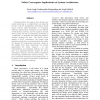Free Online Productivity Tools
i2Speak
i2Symbol
i2OCR
iTex2Img
iWeb2Print
iWeb2Shot
i2Type
iPdf2Split
iPdf2Merge
i2Bopomofo
i2Arabic
i2Style
i2Image
i2PDF
iLatex2Rtf
Sci2ools
HPCA
2008
IEEE
2008
IEEE
Fabric convergence implications on systems architecture
Converged fabrics that support data, storage, and cluster networking in a unified fashion are desirable for their cost and manageability advantages. Recent trends towards higher-bandwidths in commodity networks, physical-layer similarities across different communication protocols, and the adoption of blade servers along with the corresponding availability of "backplanes" to implement new networking methods, motivate revisiting this idea. We discuss various aspects of fabric convergence, and present some evaluation results from our experiments in the context of a specific I/O consolidation case study. Based on the insights from these experiments, we discuss opportunities for future research ? in new instrumentation and evaluation methods, new crosslayer and application-agnostic designs for fabric convergence solutions, and new system architectures that leverage ensemble-level resource sharing. Our goal, through the discussions in this position paper, is to initiate a more gen...
Broader Academic Community | Computer Architecture | Fabric Convergence Solutions | HPCA 2008 | Specific I/o Consolidation |
| Added | 01 Dec 2009 |
| Updated | 01 Dec 2009 |
| Type | Conference |
| Year | 2008 |
| Where | HPCA |
| Authors | Kevin Leigh, Parthasarathy Ranganathan, Jaspal Subhlok |
Comments (0)

